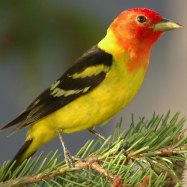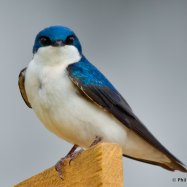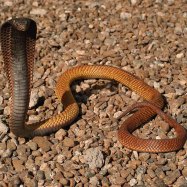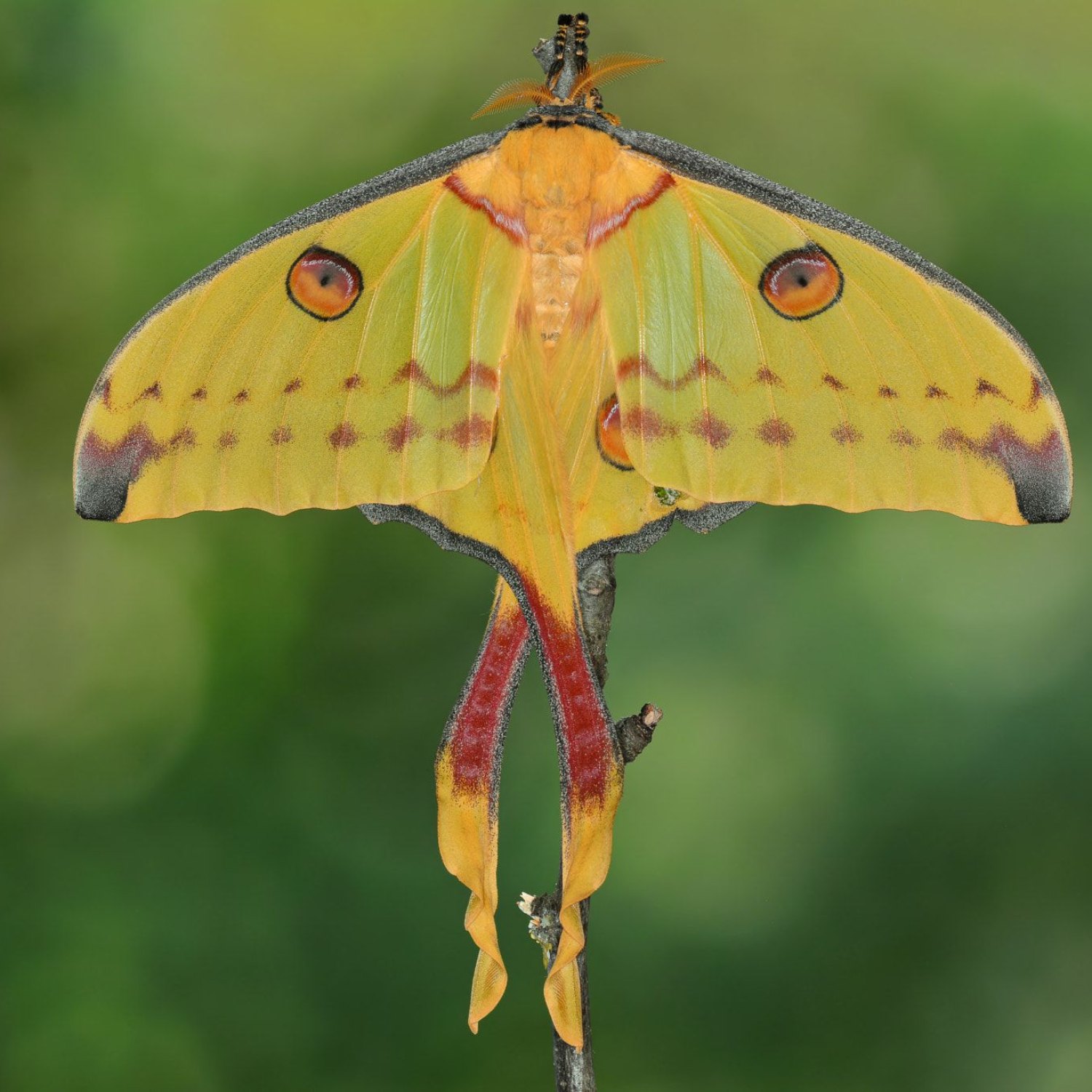
Comet Moth
Males: up to 20 cm (wingspan), Females: up to 15 cm (wingspan)
The stunning Comet Moth is a sight to behold in eastern and central Madagascar. With a wingspan of up to 20 cm in males and 15 cm in females, it belongs to the Saturniidae family. Its large, wide wingspan and long tails in males make it easily recognizable. #CometMoth #Madagascar #Saturniidae
Animal Details Summary:
Common Name: Comet Moth
Kingdom: Animalia
Habitat: Tropical rainforests
The Fascinating World of the Comet Moth
The animal world is filled with creatures both beautiful and peculiar, and one such creature that immediately catches the eye is the Comet Moth. With its striking coloration and impressive size, it is hard to miss this magnificent insect fluttering through the tropical rainforests of Madagascar.The Scientific Name and Classification of the Comet Moth
The scientific name of this stunning insect is Argema mittrei, and it belongs to the Animalia kingdom, Arthropoda phylum, and Insecta class. It is a member of the Lepidoptera order and the Saturniidae family, which also includes other species of moths such as the giant silk moths Comet Moth.The Common Name and Origin of the Comet Moth
The Comet Moth is commonly known as the Comet Moth, and it is native to the island of Madagascar. This island, located off the coast of Africa, is home to an incredibly diverse range of flora and fauna, including this remarkable species of moth.Habitat and Geographical Distribution of the Comet Moth
As mentioned earlier, the Comet Moth inhabits the tropical rainforests of Madagascar. These lush forests provide the ideal conditions for the survival and thriving of this species. The moth is typically found in the eastern and central parts of the island, where the climate is humid and warm.Feeding Habits of the Comet Moth
One of the most intriguing aspects of the Comet Moth is its feeding habits. While most adult moths feed on nectar or other plant material, the Comet Moth does not feed at all. Instead, they rely on the reserves they have built up as caterpillars. It is only in its larval stage that the Comet Moth consumes food, feasting on the leaves of specific plant species Common Furniture Beetle.A Look at the Physical Characteristics of the Comet Moth
The Comet Moth is known for its unique and exquisite appearance, making it one of the most sought-after species for collectors. The males have a bright yellow coloration, with long, flowing red and white tails, which give them the appearance of a comet, thus inspiring their name. The females, on the other hand, have a similar coloration but with shorter tails.The wingspan of the Comet Moth can reach up to 20 cm for males and 15 cm for females, making it one of the largest species of moths in the world. The body shape is also quite striking, with its broad and elongated wings, giving it an overall regal and majestic look.
The Significance of the Comet Moth's Coloration
The vibrant coloration of the Comet Moth serves as a natural defense mechanism against predators. The bright yellow color, along with the long tails, mimics the appearance of a toxic and unpalatable species of butterfly found in the same region. This adaptation allows the moth to ward off potential predators who might mistake it for a deadly species.Conservation Status of the Comet Moth
The Comet Moth is currently listed as "Least Concern" on the IUCN Red List. However, the destruction of its habitat due to deforestation poses a threat to its population. Additionally, the high demand for this species by collectors could also have a negative impact on its numbers if not regulated properly. As such, it is crucial to raise awareness about the importance of preserving the natural habitat of these magnificent creatures.Interesting Facts About the Comet Moth
- The Comet Moth was first discovered by the French entomologist and naturalist, Jean-Marie-Joseph Audinet-Serville, in the early 1800s.- The long tails of the males are actually extensions of their wings, called "modified hind wings."
- The caterpillars of this species take up to two months to develop fully and can reach lengths of up to 10 cm.
- The silk produced by the Comet Moth is not suitable for commercial use, as it is too brittle and delicate.
- The females of this species are generally larger and heavier than the males, allowing for better egg-laying capabilities.
In Conclusion
The Comet Moth is a remarkable and mesmerizing species, with its striking coloration, impressive size, and unique feeding habits. As we continue to learn about the importance of preserving our planet's biodiversity, it is crucial to also protect and appreciate the diversity found within the animal kingdom. So, the next time you find yourself in a tropical rainforest, keep your eyes peeled for this stunning moth fluttering through the trees, and let its beauty capture your heart.

Comet Moth
Animal Details Comet Moth - Scientific Name: Argema mittrei
- Category: Animals C
- Scientific Name: Argema mittrei
- Common Name: Comet Moth
- Kingdom: Animalia
- Phylum: Arthropoda
- Class: Insecta
- Order: Lepidoptera
- Family: Saturniidae
- Habitat: Tropical rainforests
- Feeding Method: Adults do not feed, caterpillars feed on specific plant species
- Geographical Distribution: Madagascar
- Country of Origin: Madagascar
- Location: Eastern and central Madagascar
- Animal Coloration: Males: yellow with long red and white tails, Females: yellow with short tails
- Body Shape: Large and wide wingspan, long tails in males
- Length: Males: up to 20 cm (wingspan), Females: up to 15 cm (wingspan)
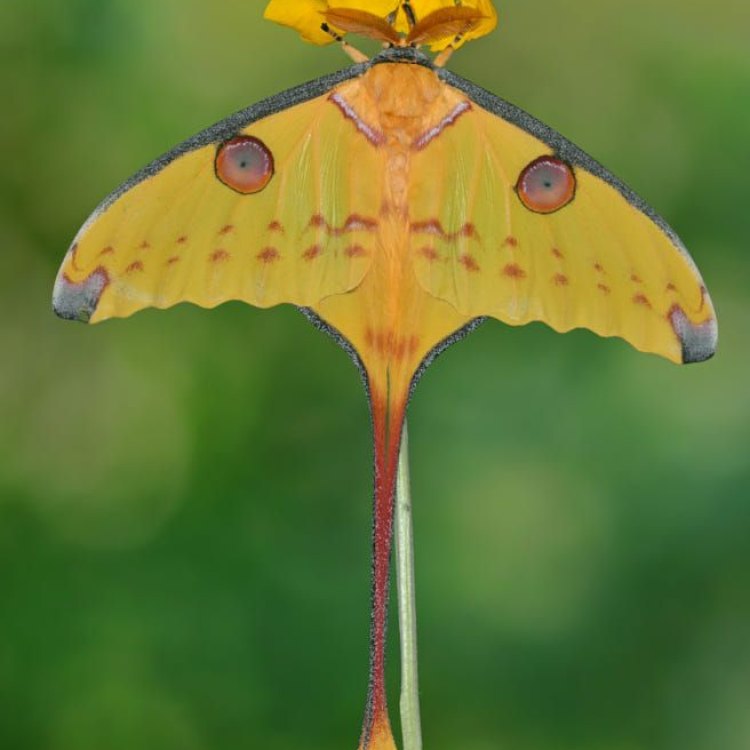
Comet Moth
- Adult Size: Large
- Average Lifespan: Approximately 5-7 days as adults
- Reproduction: Sexual
- Reproductive Behavior: Males fly and release pheromones to attract females
- Sound or Call: No sounds or calls
- Migration Pattern: Non-migratory
- Social Groups: Solitary
- Behavior: Nocturnal and attracted to light sources
- Threats: Habitat destruction and collection for the pet trade
- Conservation Status: Not evaluated (NE)
- Impact on Ecosystem: Mainly pollinators of certain plant species
- Human Use: Collected for their cocoons and used for silk production
- Distinctive Features: Long tails in males, large wingspan, colorful
- Interesting Facts: Comet moths are considered one of the largest silk moths in the world
- Predator: Birds and small mammals
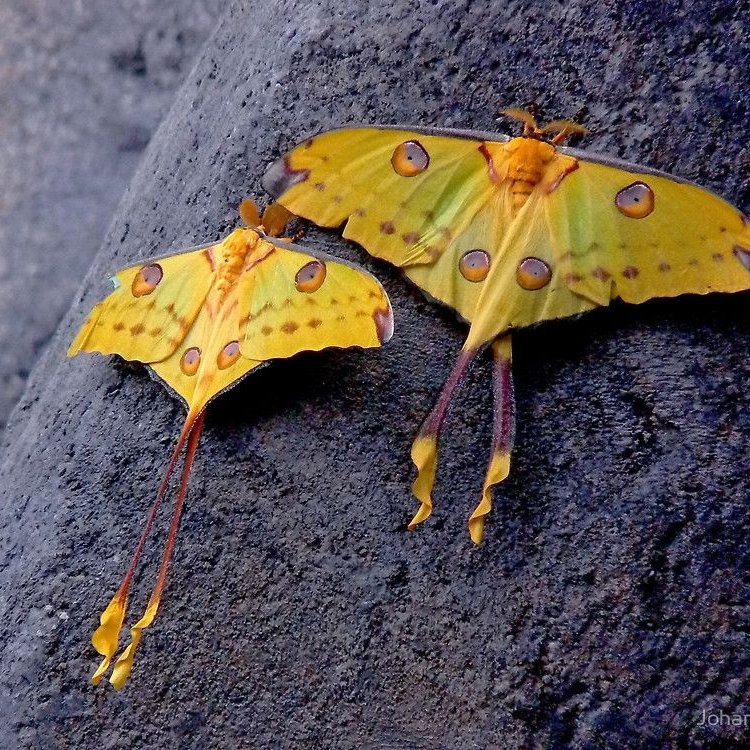
Argema mittrei
The Fascinating World of the Comet Moth: A Marvel of Nature
The world is home to over a million different species of insects, each with its unique characteristics and role to play in the ecosystem. Among these diverse creatures, there is one species that stands out with its stunning appearance and intriguing behaviors - the Comet Moth.From its distinctive physical features to its vital role in pollination and silk production, the Comet Moth has captured the attention of researchers, nature enthusiasts, and even the fashion industry. In this article, we will delve into the fascinating world of the Comet Moth and discover what makes it so unique and intriguing PeaceOfAnimals.Com.
The Basics: Adult Size, Lifespan, and Reproduction
The Comet Moth (Argema mittrei), also known as the Madagascan Moon Moth, is a large silk moth species native to the rainforests of Madagascar. It is among the largest silk moths in the world, with an adult size ranging from 6 to 10 centimeters in length and a wingspan of up to 20 centimeters. The females are slightly larger than the males, with thicker bodies and shorter tails.The average lifespan of a Comet Moth is relatively short, lasting only around 5-7 days as adults. However, their entire life cycle, which begins as a tiny egg laid by the female on the underside of a leaf, can last up to several months. The caterpillars go through several molting stages, shedding their skin and growing larger until they eventually pupate and emerge as adults.
Being a sexually reproducing species, the Comet Moth's reproductive behavior is quite simple yet fascinating. As adults, male moths fly at night, usually around midnight, and release pheromones to attract females. Once a male finds a female, he will use his long tails to hold onto her while they mate Cesky Fousek. After mating, the female will lay her eggs, and the cycle repeats itself.
Behavior and Social Groups
The Comet Moth is a solitary species, meaning they do not form social groups or colonies. They prefer to live alone and only come together for mating purposes. This behavior is not only seen in their adult stage but also in their caterpillar and pupal stages.Being nocturnal creatures, Comet Moths are most active at night, spending their days resting on leaves, staying protected from predators. They are also attracted to light sources, making them easy to spot in the darkness of the rainforest. However, unlike other moths that may be considered pests by humans, Comet Moths do not cause any harm or damage to crops or homes.
Threats and Conservation Status
The Comet Moth faces several threats in its natural habitat, the primary one being habitat destruction. Like many other species living in the rainforests of Madagascar, this moth's home is being destroyed at an alarming rate due to deforestation, mainly for agriculture and logging purposes. This destruction leads to a loss of food sources, nesting sites, and natural enemies, putting the Comet Moth at risk.Additionally, another threat to the Comet Moth is its collection for the pet trade. Due to its striking appearance, many people are drawn to keep the moths as pets, leading to a decrease in their population in the wild. However, collecting and selling this species is illegal, and efforts are being made to enforce laws to protect it.
Currently, the Comet Moth is listed as Not Evaluated (NE) by the International Union for Conservation of Nature (IUCN). This means that its conservation status has not been assessed, and more research is needed to determine its population status and any necessary conservation measures.
The Role in the Ecosystem
While the Comet Moth is not considered a crucial species in terms of food sources or predators, they do play an essential role in the ecosystem. As adults, they primarily act as pollinators for certain plant species, helping with the reproduction and survival of these plants. Furthermore, their caterpillars feed on specific tree leaves, which can help control plant populations and maintain the balance of the forest ecosystem.Human Use and Distinctive Features
Aside from being admired for its beauty and studied for its role in the ecosystem, the Comet Moth also has some unique features that make it valuable to humans. In some parts of Madagascar, the moths are collected for their cocoons, which are then used for silk production. The silk produced by this species is known for its strength and is often used to make high-quality fabric.One of the most distinctive features of the Comet Moth is its long tails, seen in the males. These tails can reach up to 15 centimeters in length, making them longer than the body of the moth itself. The tails serve no functional purpose, and it is believed that they evolved over time to attract females during mating.
Another feature that makes the Comet Moth stand out is its large and colorful wings. The wings of this species are a combination of shades of brown, beige, and green, with intricate patterns that resemble eyespots. These patterns serve as camouflage, making it difficult for predators to spot them when resting on leaves.
Interesting Facts: The Marvels of the Comet Moth
Apart from its distinctive features and behavior, there are many interesting facts about the Comet Moth, making it a truly remarkable species. Here are just a few of them:- The Comet Moth is native to the rainforests of Madagascar, but similar species can also be found in South America and Southeast Asia.
- Although they have large wingspans, Comet Moths are not strong flyers and are often found close to the ground.
- These moths do not make any sounds or calls, as they do not have the necessary organs to produce sound.
- The caterpillars of the Comet Moth go through several molting stages, with each stage lasting around two to three weeks.
- In some cultures, the Comet Moth is considered a symbol of good luck and prosperity.
Predators and Protection Mechanisms
Like any other species, the Comet Moth also has natural predators that pose a threat to its survival. Birds and small mammals, such as bats, are the main predators of this species. The moths' large wings can make it difficult for them to fly efficiently, making them an easy target for predators.To protect themselves from potential threats, Comet Moths have developed various defense mechanisms. Their wings' intricate patterns serve as camouflage, allowing them to blend in with their surroundings to avoid being detected by predators. Additionally, their cocoons are made of silk, providing a protective shield for the pupa inside.
The Importance of Protecting the Comet Moth
The Comet Moth may seem like just another beautiful insect in the rainforest, but it plays a vital role in maintaining the balance of its ecosystem. From pollinating plants to controlling their population and providing silk for human use, this species has many unique features and behaviors that make it truly fascinating.However, with habitat destruction, collection for the pet trade, and other threats, the Comet Moth's population is at risk. It is essential to raise awareness of this species and the importance of protecting it and its habitat. Efforts must be made to conserve the rainforests of Madagascar and enforce laws against the collection and trade of this species.
In conclusion, the Comet Moth is a marvel of nature, and its intricate features and behaviors make it an intriguing species to study and admire. Let us appreciate and protect this unique creature to ensure its survival for generations to come.

The Fascinating World of the Comet Moth
Disclaimer: The content provided is for informational purposes only. We cannot guarantee the accuracy of the information on this page 100%. All information provided here may change without prior notice.




